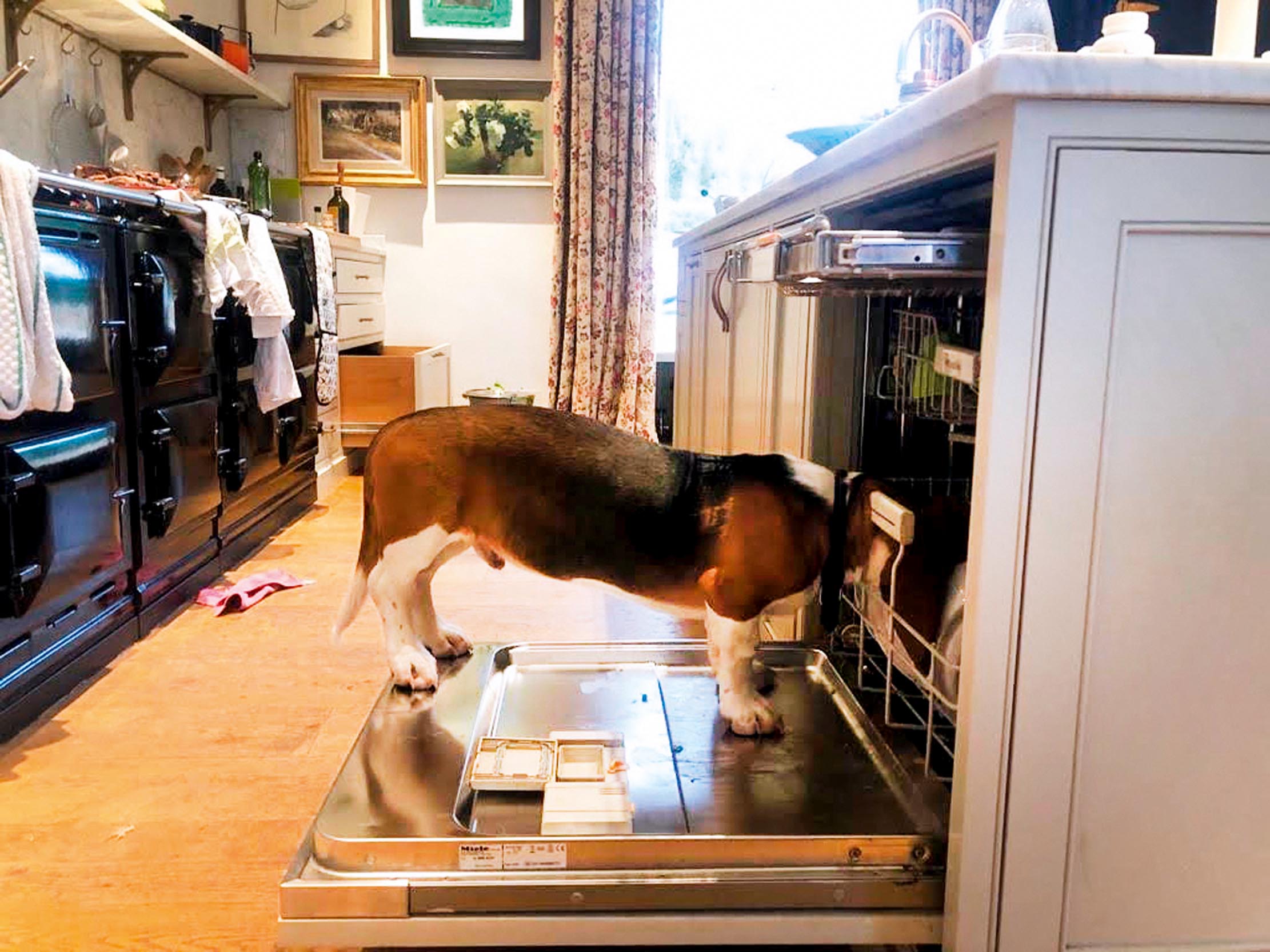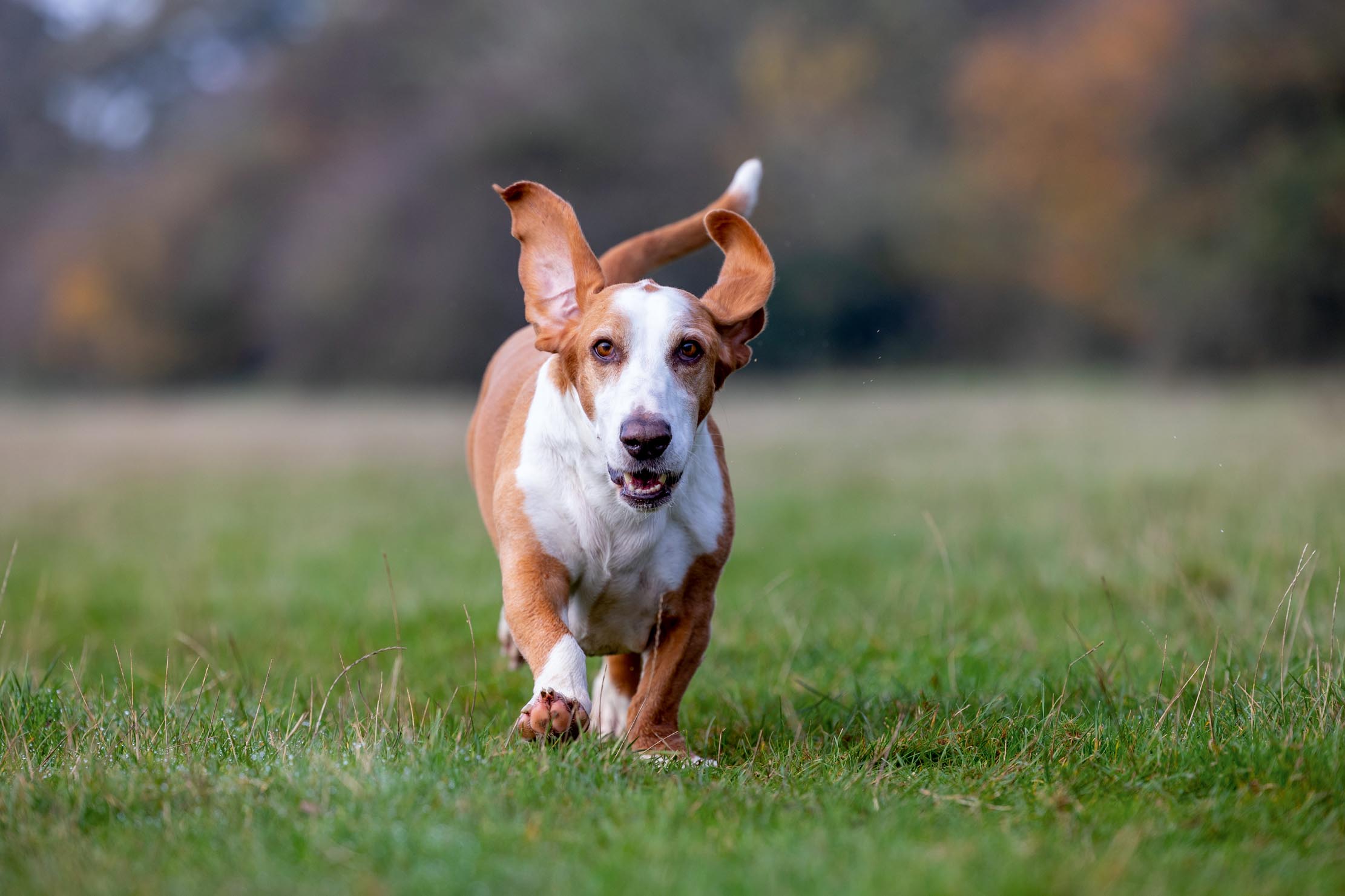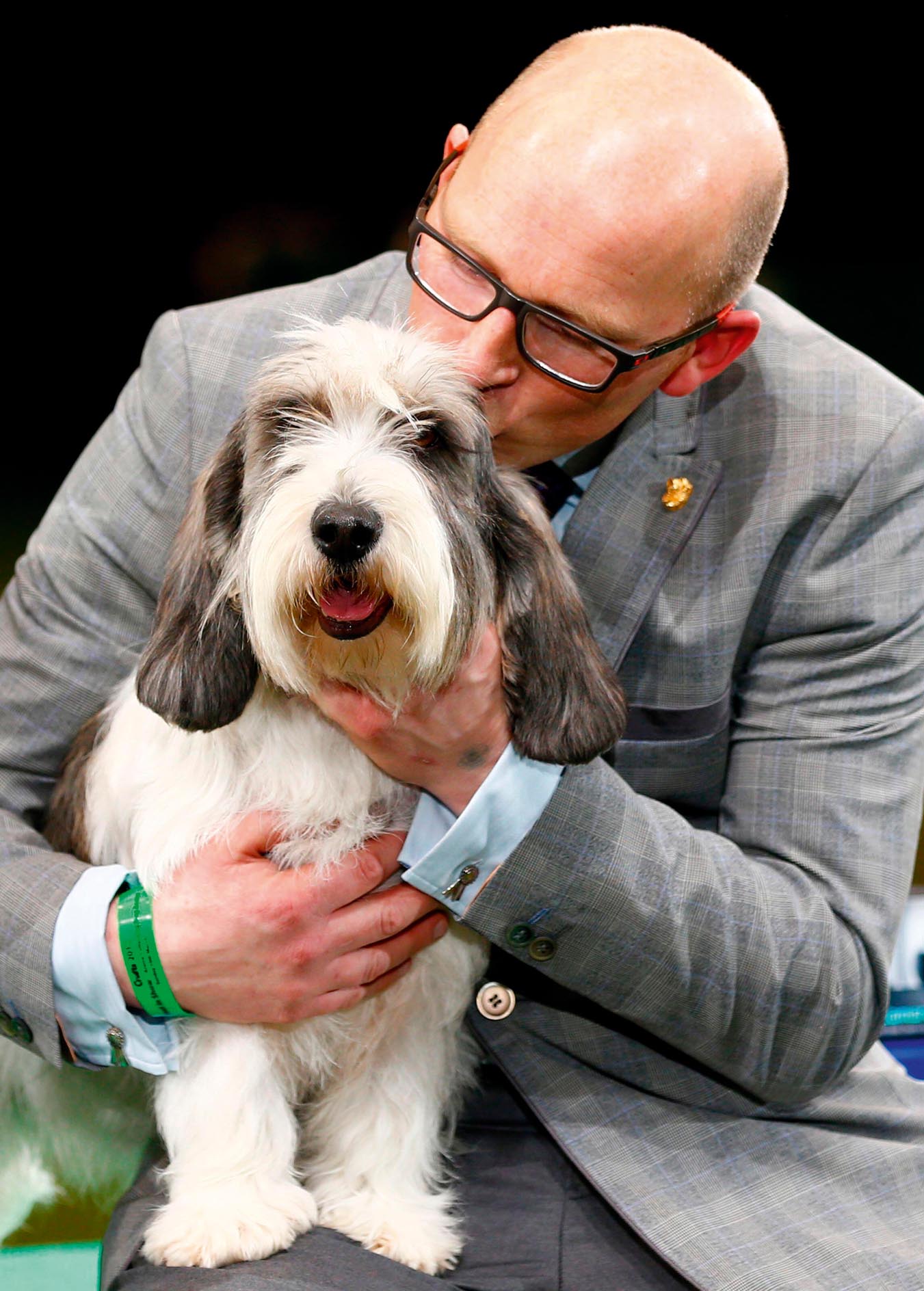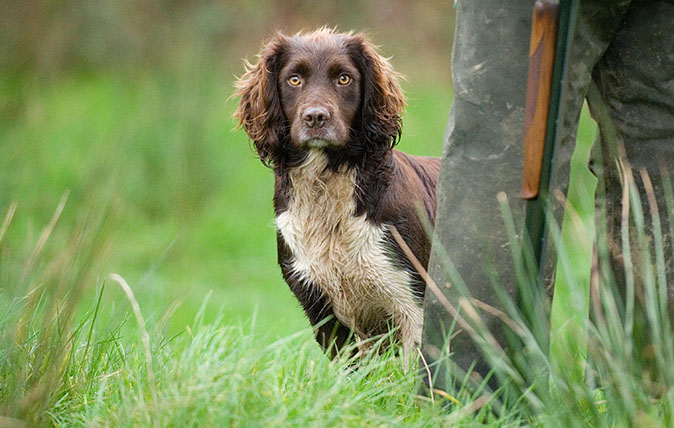Basset hounds: Incorrigible and exasperating, vocal and entertaining... and seemingly almost human
The basset hound is a force of nature, says devotee Flora Watkins.


When cartoonist Alex Graham was asked to create a strip about a thinking dog for the Daily Mail in 1963, the obvious choice was a basset hound. They are a ‘unique dog’, he said, after Fred Basset and his wry observations had ambled into the nation’s consciousness, with a ‘rather expressive face’.
Their Queen Anne legs, mournful eyes and ears that sweep the ground make the basset a gift to cartoonists and advertising executives alike. They are absurdly endearing; as I write, our two resident Hush Puppies, Wellington and Churchill, lie slumped across my feet, emitting the sort of rumbling, 80- decibel snore that would earn my husband a sharp dig in the ribs at 2am. Yet they merely elicit an indulgent smile.

Fellow basset slave Orlando Fraser is ‘completely blind’ to his dog Basil’s faults, according to his wife, Clementine. ‘All the stealing, messing and thievery goes past him and is forgiven,’ she says. Mrs Fraser bought Basil for her husband last Christmas, after years of hearing about childhood memories of his mother Lady Antonia’s basset hound.
Curiously, she adds: ‘Orlando came back from London the other day and said: “I went through the albums with Mummy over dinner and the awful thing was, Bertie the Basset died three years before I was born!”’ This is a testament, Mrs Fraser feels, to the strength of personality contained within that comical body.
Basil is adored by the Frasers’ four children, aged between six and 14, with his trailing ears — ‘He was like Dumbo when we first got him’ — and impresses with his ‘amazing ability’ to steal food.
‘He’s my “pre-wash”,’ Mrs Fraser chuckles. ‘He gets right into the dishwasher and licks the whole thing from top to bottom.’

As do my own basset hounds, Basil comes from hunting lines, so he is a more svelte and streamlined model than the Kennel Club (KC) basset. They came to England from France in 1866 (bas means ‘low’ in French), imported by Lord Galway. He sold them to Lord Onslow at Clandon Park in Surrey, who is thought to have been the first person in Britain to have hunted the hare with a pack of bassets.
Sign up for the Country Life Newsletter
Exquisite houses, the beauty of Nature, and how to get the most from your life, straight to your inbox.
Early aficionados included Sir Everett Millais, son of the Pre-Raphaelite painter Sir John and an ‘influencer’ of his day, and Princess Alexandra, who established a pack at Sandringham in the 1880s, making the breed very fashionable.
Yet, within a few decades, a story sadly familiar to so many pedigree dogs had emerged. The type of basset that found favour in the showing world had become a caricature of the breed; heavy, stuffy and cumbersome. For this reason, the Masters of Basset Hounds Association was formed in 1912, to encourage the breeding of hounds purely for hunting.

The Frasers’ Basil was bred by Andrew Sallis, master and huntsman of the Kimblewick foxhounds. His bassets are ‘remarkably fast creatures, considering they don’t look built for it’. Piglet and Pumpkin sleep on the children’s beds and refuse to be walked out with the foxhounds. ‘I think they’re concerned they’ll be put outside,’ ponders Mr Sallis. ‘They have very much staked their claim to being house dogs and think they’re superior.’
As with all bassets of my acquaintance, ‘no food is safe’ with them. ‘They have no filter and eat things other dogs would never countenance: lettuce, tomatoes,’ he adds. (Wellington’s red-letter days include a whole Victoria sponge and a sirloin of beef that had been taken out of the oven to rest before carving, but he isn’t averse to wet wipes and Play-Doh.)
Piglet and Pumpkin are purely pets. Yet, unlike many working dogs, bassets can go from field to fender very happily when they retire. Four Shires bassets have been rehomed ‘all over Oxfordshire’, says Miss Wilson (including five with her, ‘although only three sleep on my bed’). Churchill was given to us by the Albany and West Lodge at the age of five as — rather like his namesake — he proved too independent to run within the pack. He is the perfect family pet, endlessly tolerant of the baby pulling his ears (the trade-off being the ease with which he relieves her of snacks).

Two Albany bassets — one, Isla, a daughter of Churchill — have slotted into their new lives just as smoothly in the Master’s Lodge at Selwyn College, Cambridge. Roger Mosey, a former editorial director of the BBC, acquired YoYo soon after arriving in 2014, followed by Isla in 2018.
YoYo is a local celebrity. Traditionally, the Master’s Lodge has had a cat rather than a dog. ‘Technically, I didn’t need permission, but I thought it would be nice to ask the College Council,’ Mr Mosey explains. ‘The secretary thought it would be amusing to put in the minutes that the Master was given permission to keep a “Very Large Cat”.’
Later that year, Mr Mosey wrote a diary for the New Statesman. ‘There was some quite controversial stuff in the first part,’ he recalls. ‘Then, at the end, I put something about dogs taking over Cambridge. It completely took off,’ he continues, slightly bemused. ‘The story was in the Mail and The Times and YoYo was “Woof of the Week” on Sky News.’ Even today, Mr Mosey is stopped in the street and asked ‘Is that the famous Selwyn College cat?’ YoYo is an answer in the QI quiz book and there’s a picture of her on a tea towel of Cambridge.
Somehow, it’s hard to see the story of the ‘Selwyn College cat’ taking off in such a way had YoYo been yet another black lab. There is something about a basset hound that seizes the imagination. For one thing, they’re quite rare. Although the popularity of Fred Basset resulted in a six-fold increase in KC registrations during the 1960s, that has since tailed off. When I’m out with Welly and Churchill, older people often exclaim: ‘Oh, you don’t see many of those nowadays.’

I’m biased, of course, but I don’t think any other breed comes close in terms of character and traits that seem almost human. ‘The weight of them — emotional and physical — is very strong,’ thinks Mrs Fraser. Mr Mosey’s Isla is ‘incredibly loving’, although less outgoing than YoYo, who greets May Ball revellers wearing a little bow tie and ‘mooches around at their feet, hoping they drop a canapé’.
They’re extremely vocal dogs, and a pack of them can create a noise that is extraordinary, deep and resonant. Welly enjoys opera and sings along to Radio 3, although his tastes are more Classic FM; his favourite aria is the duet from The Pearl Fishers. He has an extensive vocabulary of grumbles, growls, sighs and whines: a ‘chatty basset’ is our family code for someone with too much to say for themselves.
The Duke of Edinburgh called horses ‘great levellers’, but I think it’s the basset. Caspar Withen tells me he’s known several who refuse to live in kennels, but will run round the field all day before going home, sitting on the sofa and watching Strictly Come Dancing’.
Note that the bassets watch from the sofa. Their owners probably sit on the floor.
Indeed, as I worked, Churchill inveigled his way onto the sofa beside me and, after an hour of his sighing, heavy breathing and leaning on me, I’ve given up and moved to the desk. Actually, I’m hoping to catch Strictly myself. I just need to make him a bacon sandwich first.

The champion dog trainer with a game-changing method who can teach any dog new tricks
Award-winning dog trainer Ben Randall — who looks after the dogs for everyone from David Beckham to Gordon Ramsay — happened

Credit: Sarah Farnsworth/Country Life
Fox-red labradors: Why red is the new black
From russet red to ever-so-slightly blushed, the fox-red is growing in popularity across the country sporting world. However, the gundog

Which breed makes the best gundog? The pros and cons of labradors, spaniels, terriers and more
Whether you own labradors, springers, cockers or a mix of all three, debate over which gundog is best has raged

How to pick a Labrador puppy
If you're after a labrador — aka 'the world's favourite dog' — you'll need to take some expert advice.

The dogs of Country Life: The labradors, terriers and teddy bears that we call family

The ups and downs of life with chocolate labradors: 'If one of my chocolates does something naughty, there’s no hiding. They all know it’s mine'
Chocolate labradors are becoming more and more popular — and with good reason, as Katy Birchall explains. Photographs by Millie Pilkington

Credit: Getty Images
Labradors: The all-action dogs that are just as happy lazing on the sofa as saving lives
An all-action working dog that's never happier than when lazing on the sofa? That's the labrador for you. We take

Credit: Alamy Stock Photo
If only dogs could talk: Reading the minds of Britain's 11 most popular breeds, from Labradors to Westies
Do pooches really take on the characteristics of their so-called owners? Rupert Uloth spoke to some of Britain’s most popular
-
 Why British designers dream up the most desirable hotels
Why British designers dream up the most desirable hotelsWhen it comes to hotel design, the Brits do it best, says Giles Kime.
By Giles Kime Published
-
 The five minute guide to 'The Great Gatsby', a century on from its publication
The five minute guide to 'The Great Gatsby', a century on from its publication'The Great Gatsby' sold poorly the year it was published, but, in the following century, it went on to become a cornerstone of world literature.
By Carla Passino Published